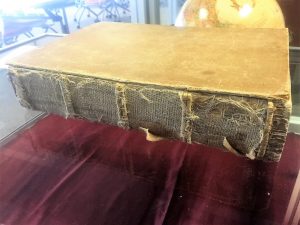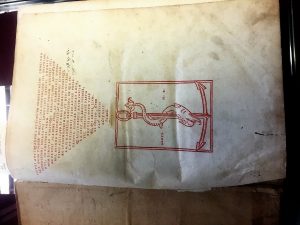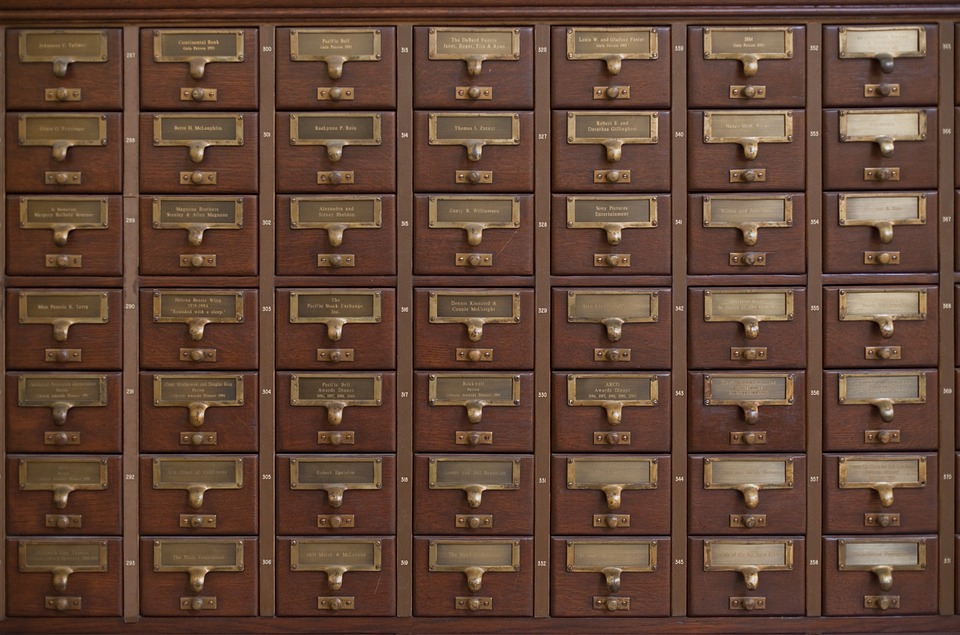This assignment asked us to explore our local collections with the help of an archivist or special collections librarian, which was very exciting to me as someone who has been working on transcribing microfilm for this library’s special collections since last semester. Finally, an opportunity to access the special collections with a more in-depth purpose! Instead of sitting in front of dual-screen computers for hours, clicking and typing, I was on the front lines: white gloves, red string, and all.

We first had to identify the oldest book in the special collections, which I did by utilizing the catalog search engine, GLOCAT, on my college’s library page. The book I found was printed in 1516, written by Lodovicus Caelius Rhodiginus, with a title so long that the collections had to cut it off to its first three words: Sicuti Antiquarum Lectionum. A loose translation of this title is “As in Past Lessons.” [Disclaimer: my Latin is very rusty, and I used Google Translate to help me with this translation. If anyone has a better translation, please comment with it!] The library’s records catalog lists this book under “encyclopedias and dictionaries,” which seems appropriate as it is a very large and heavy text. This is the extent of information I could find about the details of the book.
This edition was printed in Venice, Italy, and was gifted to Milne Library at my college, SUNY Geneseo, by Dr. Leslie Poste in 1980. Dr. Poste has a very interesting background himself, as he worked at the end of WWII to preserve and conserve books, manuscripts, and other library materials that were seized by the Germans in their occupied countries. Wikipedia cites his work as a duty to “rescue some of the finest libraries of Europe.” After his time in Europe, he was on the library faculty at Geneseo as a professor of library sciences from 1958-1978, and was ultimately an antiquarian book dealer for the remainder of his life. Rhodiginus’s encyclopedia was one of many that passed through the hands of Dr. Poste, so while I don’t believe it had a particularly profound influence on him, I think it is a good representation of his life as a preserver of European libraries and as a rare book dealer. This book was produced in Venice, Italy in 1516, which was the same year that the city officially established a Jewish ghetto known as the Venetian Ghetto, which legally instituted political restrictions on Jewish rights. Often in the Middle Ages, Latin was used in scholarly circles as means to exclude groups of people, particularly the poor and uneducated, which situates this book neatly in this time period as an educational book written exclusively in Latin.
The second task asked us to select a book from the special collections that bears evidence of reader use, which would include marginalia, marks of ownership, etc. While I explored the rest of the special collections in response to this question, I ended up back at Sicuti Antiquarum Lectionum. The marginalia in this book was the most interesting to me, although it was all in Italian. One section of the book, in particular, had the most handwritten notes in the margin. The notes were neatly placed and neatly written in a script that oozed sophistication and education. Accompanying these

notes were underlined passages. Both the sophistication of the notes as well as these underlined sections imply that this encyclopedia was intimately used as a scholarly source.
The final task in this assignment was to identify one of the specific collections in the library, and there is one clear choice for this at Geneseo’s Milne: The Wadsworth Family Papers. The Wadsworth Family is a household name in Geneseo, NY, and are considered its founding family considering their size and influence for generations. Due to their prevalence in the region, and the dedication they’re known for to higher education, they’ve chosen Milne Library as the keeper of their various family documents and books. This collection is primarily made up of family and business correspondence, various books, as well as some non-written items such as a collections of photographs taken by Mrs. Herbert Wadsworth that were donated by a relative of hers that she had kept the photos with before her death. The books in this collection are generally concerning land, political, and familial history, many written by members of the Wadsworth family themselves. While the collection of photographs were given by a relative of the Wadsworths, most of the collection was donated directly by the family.
This Social Life of Books course provides an excellent opportunity to learn more about the area that I’ve come to love and consider a second home during my undergraduate years. While I’ve learned a lot from an internship I had with the local historical society last semester about this town and county, as an English major, I’m even more excited to see what I can learn specifically from the books that are associated with it. I’m looking forward to seeing what the rest of this semester brings!

